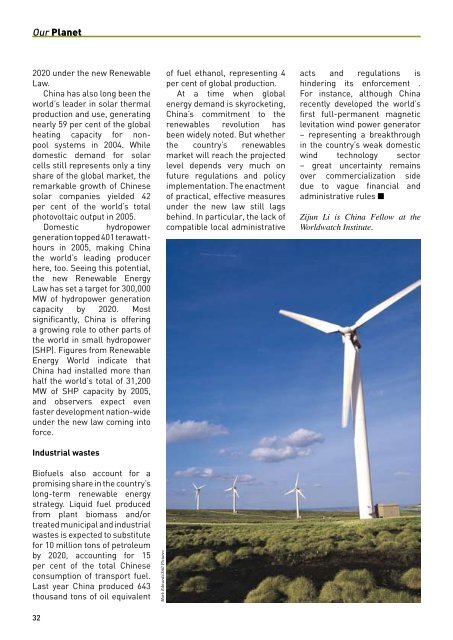UNEP Magazine "Climate change and economic development"
UNEP Magazine "Climate change and economic development"
UNEP Magazine "Climate change and economic development"
You also want an ePaper? Increase the reach of your titles
YUMPU automatically turns print PDFs into web optimized ePapers that Google loves.
Our Planet<br />
2020 under the new Renewable<br />
Law.<br />
China has also long been the<br />
world’s leader in solar thermal<br />
production <strong>and</strong> use, generating<br />
nearly 59 per cent of the global<br />
heating capacity for nonpool<br />
systems in 2004. While<br />
domestic dem<strong>and</strong> for solar<br />
cells still represents only a tiny<br />
share of the global market, the<br />
remarkable growth of Chinese<br />
solar companies yielded 42<br />
per cent of the world’s total<br />
photovoltaic output in 2005.<br />
Domestic hydropower<br />
generation topped 401 terawatthours<br />
in 2005, making China<br />
the world’s leading producer<br />
here, too. Seeing this potential,<br />
the new Renewable Energy<br />
Law has set a target for 300,000<br />
MW of hydropower generation<br />
capacity by 2020. Most<br />
significantly, China is offering<br />
a growing role to other parts of<br />
the world in small hydropower<br />
(SHP). Figures from Renewable<br />
Energy World indicate that<br />
China had installed more than<br />
half the world’s total of 31,200<br />
MW of SHP capacity by 2005,<br />
<strong>and</strong> observers expect even<br />
faster development nation-wide<br />
under the new law coming into<br />
force.<br />
Industrial wastes<br />
Biofuels also account for a<br />
promising share in the country’s<br />
long-term renewable energy<br />
strategy. Liquid fuel produced<br />
from plant biomass <strong>and</strong>/or<br />
treated municipal <strong>and</strong> industrial<br />
wastes is expected to substitute<br />
for 10 million tons of petroleum<br />
by 2020, accounting for 15<br />
per cent of the total Chinese<br />
consumption of transport fuel.<br />
Last year China produced 643<br />
thous<strong>and</strong> tons of oil equivalent<br />
Mark Edwards/Still Pictures<br />
of fuel ethanol, representing 4<br />
per cent of global production.<br />
At a time when global<br />
energy dem<strong>and</strong> is skyrocketing,<br />
China’s commitment to the<br />
renewables revolution has<br />
been widely noted. But whether<br />
the country’s renewables<br />
market will reach the projected<br />
level depends very much on<br />
future regulations <strong>and</strong> policy<br />
implementation. The enactment<br />
of practical, effective measures<br />
under the new law still lags<br />
behind. In particular, the lack of<br />
compatible local administrative<br />
acts <strong>and</strong> regulations is<br />
hindering its enforcement .<br />
For instance, although China<br />
recently developed the world’s<br />
first full-permanent magnetic<br />
levitation wind power generator<br />
– representing a breakthrough<br />
in the country’s weak domestic<br />
wind technology sector<br />
– great uncertainty remains<br />
over commercialization side<br />
due to vague financial <strong>and</strong><br />
administrative rules n<br />
Zijun Li is China Fellow at the<br />
Worldwatch Institute.<br />
32

















